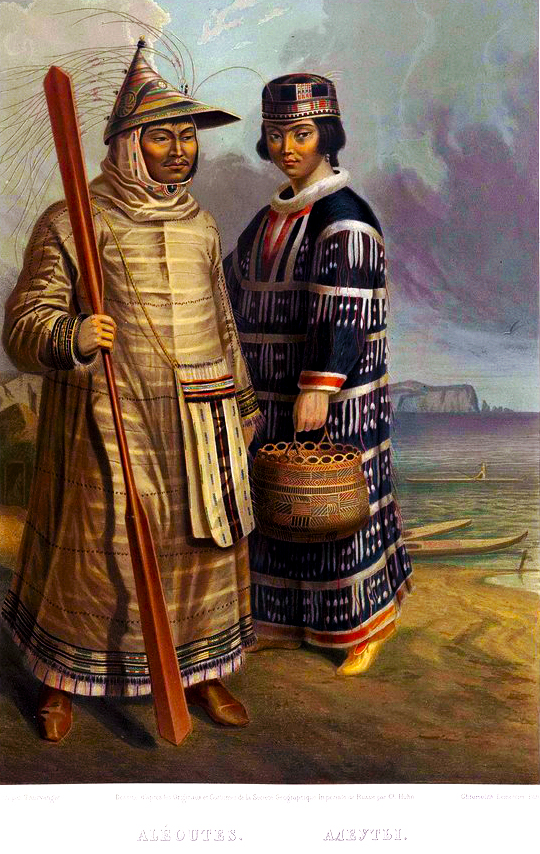|
Chagudax
Unangan hunting headgear are wooden hats associated with the Unangan or Unangas, the Indigenous peoples of what are currently known as the Aleutian Islands. Also known as bentwood hats, and hunting hats, the headgear take the form as either closed crown conical hats, with long frontal bills; open crown hats, with long bills; or visors with short bills.Ivanov, ''Aleut Hunting Headgear and Its Ornamentation'', 269. Closed crown conical hats were historically worn by chiefs, whalers, and high-ranking sea hunters, while open crown hats and visors were worn by regular and lower-rank sea hunters. These hats are recognized by their distinctive shape, elaborately painted designs and artistry, as well as their ornamentation with bone carvings and sea lion whiskers. Russian and European explorers collected many Unangan wooden hats in the late 18th and 19th century. These hats are now part of many museum collections around the world. Since the 1980s, contemporary Alaska Native artists have ... [...More Info...] [...Related Items...] OR: [Wikipedia] [Google] [Baidu] |
Bentwood
Bentwood objects are made by wetting wood (either by soaking or by steaming), then bending it and letting it harden into curved shapes and patterns. Furniture-makers often use this method in the production of rocking chairs, cafe chairs, and other light furniture. The iconic No. 14 chair (also known as the "Vienna chair"), developed in the 1850s in the Austrian Empire by Thonet, is a well-known design based on the technique. The process is in widespread use for making casual and informal furniture of all types, particularly seating and table forms. It is also a popular technique in the worldwide production of furniture with frames made of heavy cane, which is commonly imported into European and Western shops. Bentwood boxes are a traditional item made by the First Nations people of the North American west coast including the Haida, Gitxsan, Tlingit, Tsimshian, Sugpiaq, Unangax, Yup'ik, Inupiaq and Coast Salish. These boxes are generally made out of one piece of wood that i ... [...More Info...] [...Related Items...] OR: [Wikipedia] [Google] [Baidu] |
Aleut
Aleuts ( ; (west) or (east) ) are the Indigenous people of the Aleutian Islands, which are located between the North Pacific Ocean and the Bering Sea. Both the Aleuts and the islands are politically divided between the US state of Alaska and the Russian administrative division of Kamchatka Krai. This group is also known as the Unangax̂ in Unangam Tunuu, the Aleut language. There are 13 federally recognized Aleut tribes in the Aleut Region of Alaska. In 2000, Aleuts in Russia were recognized by government decree as a small-numbered Indigenous people. Etymology In the Aleut language, they are known by the endonyms Unangan (eastern dialect) and Unangas (western dialect); both terms mean "people". The Russian term "Aleut" was a general term used for both the native population of the Aleutian Islands and their neighbors to the east in the Kodiak Archipelago, who were also referred to as "Pacific Eskimos" or Sugpiat/Alutiit. Language Aleut people speak Unangam Tunuu, ... [...More Info...] [...Related Items...] OR: [Wikipedia] [Google] [Baidu] |
Unangan Parka Hat Bag Basket KFGun 1862 LC MoF
Aleuts ( ; (west) or (east) ) are the Indigenous people of the Aleutian Islands, which are located between the North Pacific Ocean and the Bering Sea. Both the Aleuts and the islands are politically divided between the US state of Alaska and the Russian administrative division of Kamchatka Krai. This group is also known as the Unangax̂ in Unangam Tunuu, the Aleut language. There are 13 federally recognized Aleut tribes in the Aleut Region of Alaska. In 2000, Aleuts in Russia were recognized by government decree as a small-numbered Indigenous people. Etymology In the Aleut language, they are known by the endonyms Unangan (eastern dialect) and Unangas (western dialect); both terms mean "people". The Russian term "Aleut" was a general term used for both the native population of the Aleutian Islands and their neighbors to the east in the Kodiak Archipelago, who were also referred to as "Pacific Eskimos" or Sugpiat/Alutiit. Language Aleut people speak Unangam Tunuu, the A ... [...More Info...] [...Related Items...] OR: [Wikipedia] [Google] [Baidu] |
Hunting Hat, Aleut - Etholén Collection, Museum Of Cultures (Helsinki) - DSC04917
Hunting is the human practice of seeking, pursuing, capturing, and killing wildlife or feral animals. The most common reasons for humans to hunt are to obtain the animal's body for meat and useful animal products (fur/ hide, bone/tusks, horn/antler, etc.), for recreation/taxidermy (see trophy hunting), although it may also be done for resourceful reasons such as removing predators dangerous to humans or domestic animals (e.g. wolf hunting), to eliminate pests and nuisance animals that damage crops/livestock/poultry or spread diseases (see varminting), for trade/tourism (see safari), or for ecological conservation against overpopulation and invasive species (commonly called a cull). Recreationally hunted species are generally referred to as the ''game'', and are usually mammals and birds. A person participating in a hunt is a hunter or (less commonly) huntsman; a natural area used for hunting is called a game reserve; and an experienced hunter who helps organise a hunt and ... [...More Info...] [...Related Items...] OR: [Wikipedia] [Google] [Baidu] |


